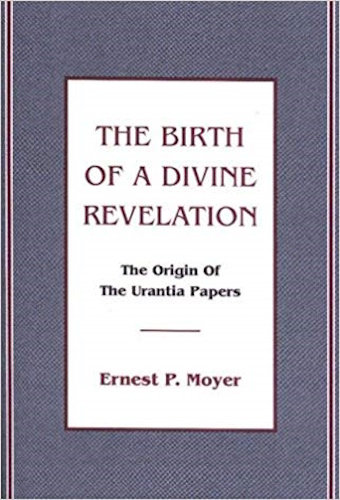
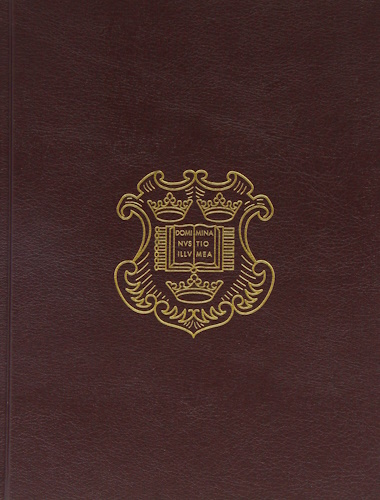





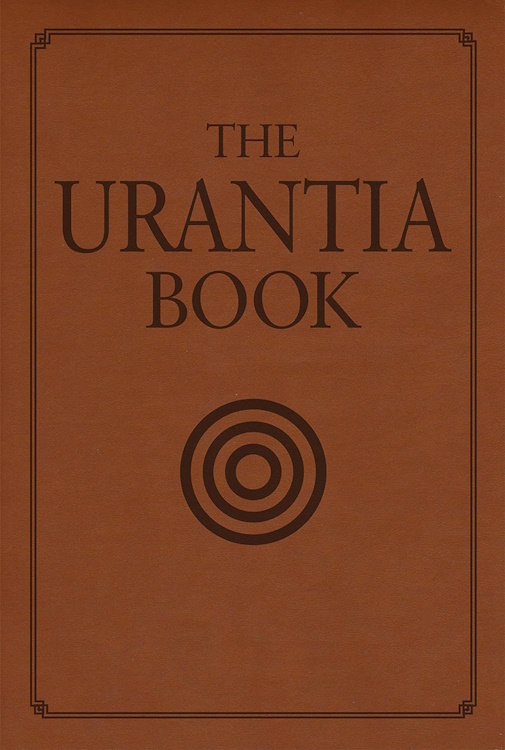

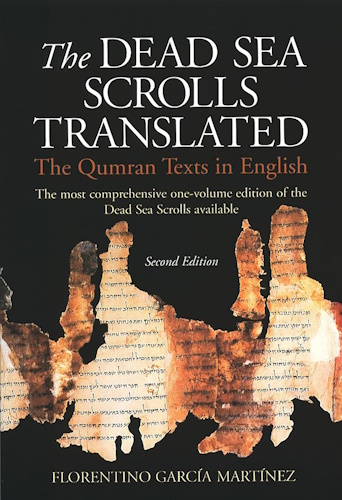





![]()
![]()
CHAPTER 5
THE HUMAN AGENT
An account of how a new revelation was given to this planet is really an account of how a human being was used by celestial agents and how they prepared him to accept their presence and intimate activity in the modern secular environment. William S. Sadler of Chicago, Illinois was the individual used to accomplish this extraordinary feat but, by Sadler's own admission, it was done without his full understanding.
The Who's Who In Chicago, for 1926, and the Who's Who In Chicago and Illinois, for 1945, show Sadler as a highly trained professional, a medical doctor, senior surgeon and attending psychiatrist at Columbus Hospital, Director and chief psychiatrist of the Chicago Institute of Research and Diagnosis which he founded in 1906, professor of pastoral psychology at McCormack theological seminary, professor in the Post-Graduate Medical School of Chicago, consulting psychiatrist to the W. K. Kellogg Foundation of Battle Creek, Michigan, famous lecturer on the rural Chautauqua circuits, and prolific writer of popular medical articles and books. He wrote a psychiatric text used in medical schools for many years. He was also a member of numerous professional organizations, including Fellow of the American College of Surgeons, American Medical Association, American Association for the Advancement of Science, American Public Health Association, American Psychiatric Association, American Psychopathological Association, and well as other city and state professional organizations.
This list of credentials makes it plainly evident that Sadler was a straight-laced, middle- of-the-road conservative, who believed fully in the American way of life and spent his energies in service to his fellow human mortals in effort to improve their general welfare. He was a sharply practical, no-nonsense man; he was not one to be swayed by foolishness, pretense, or illusions. And he was vigorously opposed to psychic phenomena.
The Urantia Foundation will not now make Sadler's files and papers available to research; therefore, our knowledge of Sadler's history must be gleaned from other sources. Much of what we know of Sadler's early life is due to C. Vonne Meussling, who had access to Sadler's private papers in 1969, shortly after his death. She also interviewed Anne Rawson, Sadler's private secretary for seventeen years, Emma L. Christensen, Sadler's adopted daughter, and other members of his family. Meussling became interested in Sadler through Meredith Sprunger when both Meussling and Sprunger were on the teaching staff of Indiana Institute of Technology in Fort Wayne, Indiana. Sprunger met Sadler in the late 1950's and spent many hours in private conversation with him. Meussling engaged in research on Sadler as part the requirements for a Doctor of Philosophy in speech from Bowling Green State University. She had chosen Sadler as her subject because of his reputation as an outstanding orator, and his prevalent influence upon health attitudes in rural America through the Chautauqua circuits in the early 1900's. Meussling listed two reasons for her interest in Sadler:
"Sadler was a pioneer of his day. His deliberate efforts to reach large audiences to bring the message of health was unprecedented for a man of the medical profession. Through his public speaking he helped focus attention on some of the vital health issues of the day."
"The importance of public oratory in a democratic society and its particular force in the history of medicine may be reflected in the career of William S. Sadler."
As indication of Sadler's influence, Meussling cited from a report by managers of the Chautauqua circuit:
Chautauqua audiences had developed the practice of showing appreciation on Sundays (when they did not think it appropriate to applaud aloud) by a gesture which became known as the Chautauqua salute -- a waving of handkerchiefs. One historian writes: "For decades the practice of waving handkerchiefs persisted. Not until just before the First World War did a Chicago doctor, lecturing on the Chautauqua circuit on causes of the common cold, finally succeed in putting a stop to the practice. Dr. William Sadler was a psychiatrist. Fortunately for Chautauqua he respected the germ theory as much as he did Freud; it was he who, after one startling experience with the 'Chautauqua salute,' drove it out of business(1)."
William Samuel Sadler was the son of Samuel Cavins and Sarah (Wilson) Sadler. He was born on June 24, 1875, in Spencer, Indiana, and was the oldest of three children. According to a remark in one of his books, The Truth About Spiritualism, page 170, his two younger siblings were twin sisters. His father was a graduate of the Chicago Conservatory of Music, who went on to become a musical teacher and performer. His parents first sent the children to public school, but when one of the sisters died of a childhood disease they withdrew the other two. His obituary, published in the Chicago Tribune for April 27, 1969, shows that he was survived by the other sister, Mary Sadler, in Seattle, Washington. Sadler was then 93 years old.
Apparently as the result of this death experience the parents converted to Seventh Day Adventism, which stressed physical health as a crucial component of devout religious living. At that time the Sadler family became aware of the many religious social activities of that Church. Hence, the father decided to dedicate himself to religious work, and spent his remaining days evangelizing and selling Bibles.
Sadler grew up in Wabash, Indiana. He received most of his early education from his parents and tutors, and through his own initiative. While living in Wabash, a relative, General McNaught, onetime chief of scouts to General U. S. Grant, gave him first-hand accounts of the Civil War. He further educated himself through use of the library of General Lew Wallace, a close neighbor, who at the time was writing Ben Hur. This exposure to history stimulated an active mind; he later recalled laying out battle maps in his back yard.
Very early Sadler exhibited public speaking abilities. During a family reunion General McNaught asked him if he would give a speech on the great battles of history. McNaught was amazed at Sadler's apperception. This led to his first formal speech at the age of eight when he addressed a high school commencement in Indianapolis on "The Crucial Battles of History."
A few years later he found an old Bible in the attic of his parents home. He took the opportunity to use a deserted church across the street from his house, where he assembled his baseball buddies, and for several afternoons, played "church." His gang became the audience and he became the "preacher." This desire for public speaking reverberated throughout his life.
According to a 1906 letter to Ellen White, prophetess of the Seventh Day Adventist faith, Sadler stated that he became an Adventist at age 11, and was baptized into the church at age 13. William Covert was the minister who baptized him.
At the age of fourteen Sadler left home and moved to Battle Creek, Michigan. There he started working as a bell boy at the world renowned Battle Creek Sanitarium operated by the Seventh Day Adventist Church and headed by Dr. John Harvey Kellogg. Dr. Kellogg had a worldwide reputation for helping cure tuberculosis and other debilitating diseases. As part of his search for vegetarian diets he was a great innovator of the processing of grains which became our modern breakfast foods. He also had tremendous influence on the minds and aspirations of young people who worked with him. Although Kellogg had no natural children he and his wife adopted some forty orphans. Dr. Kellogg recognized that the future of the world depended on young people; he worked to educate them, and to give them wider perspectives of creation. According to Caroline L. Clough, a Kellogg biographer, "In those days he did much toward giving needed counsel, direction, and even financial assistance to young men who were struggling to get ahead." When Sadler joined the work at the Sanitarium he fell directly under the influence of that inspiring man.
Before and after work Sadler attended Battle Creek College. He organized a group of students who met at 5:00 AM to study rhetoric under Professor Bell, founder of the Battle Creek College, and Latin from Professor Percy McGann. Sadler's organizational abilities early became evident; it was in demand by others later in his life.
When he was sixteen years old he visited a church in Ft. Wayne, Indiana. The minister extended an open invitation for the laity to address the congregation. Sadler impulsively accepted the opportunity. After church the minister called him into his study and inquired concerning his knowledge of the Bible. Thereupon the minister asked Sadler to preach while he was away on a two-week vacation. Sadler's eagerness resulted in his delivering both morning and evening sermons. His preaching was so effective he received many letters of commendation. The local newspaper, referring to his unusual abilities, called him "the boy preacher."
While at Battle Creek Sadler also formed the Young Men's Intelligence Society, a group designed to perform detective work. This interest also found useful application several times later in his life.
When Sadler entered the scene at Battle Creek in 1889 the town was in dynamic, even explosive, growth as a health rehabilitation center, and the producer of health foods. John Harvey Kellogg's success with health cures was spreading far and wide, even to the rich of America and the royalty of Europe. As patients returned home they carried with them the knowledge of processed grains as breakfast foods; they would mail order for more. The demand became so great that Dr. Kellogg opened his first production factory in 1877. His younger brother, William Keith Kellogg, who later became the Corn Flake King, had gone to work for the Doctor as maintenance manager of the Sanitarium. Soon he was also in charge of the food factories under the name Battle Creek Sanitarium Food, Co(2). As business manager W. K. Kellogg had come to know Sadler intimately, with recognition of his outstanding abilities. He asked Sadler to become a salesman for the breakfast food side of the business. Sadler soon was noted for his sales success.
However, Dr. Kellogg did not want to commercialize the breakfast food activity, even though his brother saw an opportunity for business success. Dr. Kellogg saw it as adjunct to the Sanitarium, for charitable purposes. Later this difference brought the two Kellogg brothers into direct confrontation. Meanwhile C. W. Post, upon entering the Sanitarium for treatment, saw the advantage of the dry breakfast foods. During Post's stay he visited the research laboratories to learn the secrets of breakfast cereal production, much to the dismay of W. K. Kellogg. After leaving the Sanitarium he started his own health facility in Battle Creek, with similar production of dry grain foods. These foods again became so successful Post went into fullfledged cereal production. His company became one of the leading cereal producers of American breakfast food. Post's success was a direct challenge to W. K. Kellogg. By 1906 W. K. Kellogg resigned his position with the Sanitarium to start his own business. He was then 46 years old. Because Dr. Kellogg did not want health foods commercialized he brought legal suit against his brother to prevent use of the Kellogg name. As a result the homes of America saw the name W. K. Kellogg, and not merely Kellogg upon the boxes which decorated their breakfast tables for a hundred years. J. H. Kellogg had an influence upon American life style which extended far beyond the sanitarium at Battle Creek.
In 1893 Dr. Kellogg, fully aware of Sadler's organizational and sales abilities, asked him to join the Seventh Day Adventist operations in Chicago. Dr. Kellogg that year had founded the Chicago Medical Mission, as the International Medical Mission and Benevolent Society. With several different centers operating under that organization, Kellogg had a need for outstanding talent. Those operations included the Mission Training School, Life Boat Mission, Free Dispensary, Working Men's Home, Day Nurseries, Chicago's first free baths, and the News Boys' Club. Available evidence suggests that Sadler shuttled back and forth between Battle Creek and Chicago from 1893 to 1895. At twenty years of age he went permanently to Chicago where he was placed in charge of the Life Boat Mission(3)
There Sadler was engaged in teaching, speaking, and working with "skid row" people. He initiated and edited a magazine, The Life Boat, which rapidly increased in circulation. He also managed its large financial budget. The first issue of the magazine was in March, 1898. It shows Sadler as Editor, at age 23, with the opening editorial by Sadler.
While carrying this heavy work schedule, Sadler was urged by Kellogg to enroll as a special student at the Moody Bible Institute. The archival records of the Institute show that he entered the week ending Sept 1, 1896 but an annotation states that he later "dropped out." In typical humble fashion he listed his occupation as "office work" and his education as "Battle Creek College." He gave his permanent address as 1926 Wabash Ave., Chicago. He stated that he was Seventh Day Adventist and that he was "converted" in 1889. (This statement contradicts his remarks in the 1906 letter to Ellen White.) He listed his "Christian Work Done" as "Sunday School and Social Purity Work for Young Men." In the blank for "Proposed Work" he gave "As led." His means of support were "Work," and his personal references were Rev. Henry Nicola of 123 Manchester St. of Battle Creek, Lycurgus McCoy of Battle Creek, and J. H. Kellogg. On the reverse of the personal information card is the remark, "Excellent Christian young man, faithful in his studies." He must have continued his studies. Later annotations on the reverse of the card show him as a "Chicago Bible Teacher," under "International Medical Missionary Association" for the dates of Dec. 1897, Dec. 23, 1898 and Dec. 8, 1900. Thus the dates on the card cover a period of four years. In two written comments by Sadler, one in the Seventh Day Adventist Herald and Review, and the other in The Life Boat, he states that he attended for two years, even though he did not graduate and did not receive a certificate. Upon my inquiry the school stated they had no transcript of his grades, showing dates and courses attended. Perhaps Sadler intended that he did the equivalent of two years of study over the four-year period.
Sadler became a licensed minister of the Seventh Day Adventist Church in 1899, and an ordained minister in 1901.
During this same period, working with the Society For The Suppression Of Vice, and with United States Post Office Inspectors in the city of Chicago, Sadler figured prominently in the exposure of a number of illicit printers and purveyors of pornography. As editor of The Life Boat, he naturally came into contact with those official organizations.
The experience with skid row people gave Sadler unique insights into human behavior. When he periodically returned to Battle Creek the gymnasium would be filled with nurses and staff to listen to his inspiring accounts of the work with the outcasts of Chicago. That early experience was a key factor in the later direction of Sadler's life and his ensuing interests. It was also the catalyst for a most exceptional event which was to unfold into the birth of a divine revelation.
Meanwhile, on December 3, 1897, in Paris, Illinois, Sadler married Lena Celestia Kellogg, daughter of Smith Moses Kellogg, a half brother to both J. H. and William K. Kellogg. They met in 1893 in Battle Creek while Lena was a student nurse at the Sanitarium. In 1899 their first son, Willis, was born but the infant only lived nine months. During the period from 1897 to 1900 both Sadlers are listed at 1926 Wabash Ave. in various issues of the Seventh Day Adventist General Conference Proceedings. The United States Census for 1900 also shows them at the same address among seventy other "boarders." The Chicago Mission ran a dormitory for both single individuals and married couples, with a common dining room.
Other records from the Seventh Day Adventist Conference proceedings show Sadler attending many important meetings. He and Lena repeatedly contributed articles to the Review and Herald, the Church's official journal, and to Youth's Instructor, a magazine designed for the youth of the Church. Refer to attached lists.
In 1901 J. H. Kellogg requested that Sadler leave Chicago to become part of the management team for new Mission activities in San Francisco. After their move, both Sadler's enrolled in the Cooper Medical College of the Leland Stanford University. In attempt to reduce Lena's grief over the death of their infant son, Sadler had promised to enter medical school, which Lena had been urging since they were first married. While in medical school Sadler was in charge of several Mission operations in San Francisco. He and Lena also operated a boarding house for medical students, and tutored chemistry to help earn their livelihood.
In a Church publication Lena is listed at 971 Howard St. in San Francisco in 1901. From San Francisco General Conference letterheads used by Sadler from August, 1901 he also gives his address at the same location. Those letterheads show him as Superintendent of Young People's Work. Other letterheads show him as President of the San Francisco Medical Missionary and Benevolent Society from May, 1902 until October, 1903.
In San Francisco the Sadler's became close friends with William (Willie) White, the son of Ellen White. They also came to know Mrs. White intimately.
By this time Sadler was well known in the Seventh Day Adventist Church. His abilities and potentials attracted much attention. Unfortunately, a situation developed in San Francisco which caught Sadler directly between two opposing forces of the Seventh Day Adventist Church, between J. H. Kellogg and Ellen White, the two people he most respected. I shall discuss this more fully in the following chapter where I show how the human agent was taken.
In December, 1903 the Sadlers returned to Chicago on their own initiative. They were on the train to Battle Creek on Christmas day in 1903, where Sadler wrote a letter to Willie White. A series of letters to Willie White from early January to April, 1904, on Sanitarium letterhead, show the Sadlers at Battle Creek during that period. They then moved to La Grange, Illinois, a suburb of Chicago, where they found residence at 38 Calendar Street. Records at the University of Chicago show they matriculated in 1904 but did not receive degrees from that institution. (Rush Medical College did not become part of the University of Chicago until 1919.) They both attended the Adventist American Medical Missionary College where they received medical degrees in 1906. They received M.D. licenses the same year. In a letter to Willie White dated Feb. 7, 1907 Sadler states:
"Yesterday I saw the report of the State Board examination we took in October, and learned, much to my surprise, that I secured the highest grade awarded any candidate, 89; only three others made that grade, and all of them were graduates of Rush Medical College."
From city and telephone directories for La Grange and Chicago, from personal letters, and from newspaper advertisements we know the location of the Sadler's private residence from 1904 until their respective deaths.
Sadler continued to work within the Church for about two years at the Hinsdale Mission, directed by Dr. David Paulson, which had recently moved out to the suburbs from Chicago. The Medical Missionary College was then also operating in Hinsdale, and the two elements, assisting Mission work, and the school, may have led to the decision by the Sadler's to live in La Grange, a neighboring suburb.
Young Sadler, in spite of his experience as a speaker, also sought training in speech while attending the University of Chicago. A woman professor, after hearing his first speech said: "Get out of here. I can't teach you anything. You're very bad; your gestures are atrocious. But you are so effective I wouldn't change anything about you. I'll ruin you if I change you." Years later, after Dr. Sadler delivered a commencement address at the same University, she came to him and said, "You're just as bad as ever but so very effective. You can just hold an audience spellbound; I'm so glad we didn't change you."
In 1906, after his graduation from medical school, Dr. William Lowe Bryan, president of Indiana University at Bloomington, offered Sadler a position as head of the medical department. Although he had signed a contract and leased a house, the night before he was to move to the University he decided he could do more for his fellow man if he were free to give lectures and to write books on human adaptations to life, and the maintenance of mental and physical health. The Chicago skid-row experience also kept Sadler in its grip. He eschewed an academic life in favor of service to his fellow man.
The Sadlers then began private medical practice out of their residence at 38 Calendar Street. We know from Sadler letters that they opened their house to nurses then attending the SDA school in Hinsdale. Other notices show them offering Physician services at that address in February, 1907. They gave their office hours before 9:00 AM and as 5-7:00 PM. There telephone number was 1571. In the same notice they show their office hours at 100 State St. in Chicago as 3-4:00 PM. The Chicago telephone number was Central 257. This is where Sadler began the Chicago Institute for Research and Diagnosis. The purpose of the institution was to render diagnostic and surgical services, plus physical and psychological therapeutic assistance to patients referred by other doctors.
In 1907 they had another son, William Samuel Sadler, Jr., who later was actively associated with dissemination of The Urantia Papers.
City directories and newspaper notices show the Sadlers continuing their residence at the single family dwelling at 38 Calendar Street until April, 1908, when their lease expired. At that time they purchased a single family dwelling at 56 S. 6th St. in La Grange from Susan and James Beatty. The condition of the Deed stated that the Sadlers had to respect "existing leases expiring." The date of the real estate transfer was April 4, 1908. The property was directly behind the La Grange Town Hall, but has since been razed to make a parking lot for the City. They continued to live at that address until 1913, when they sold the property to a James Slapak in November. Local notices stated that Slapak's wife Wilhelmina would establish offices at that address as a physician.
In those early years many people and organizations sought Sadler's organizational ability. Not only had David Paulson requested his help in the organization of the Hinsdale Sanitarium, a Guggenheim family offered to spend six million dollars, a large sum for those days, to establish a combination hotel and sanitarium in a northern Chicago suburb. They would have given Sadler fifty-one percent of the stock if he administered the operation. The contract specified that Sadler must give himself full-time to the work. But Sadler was adamant concerning his personal goals; he would not sign the contract. The decision must have been a major step for Sadler; a sketch of the never-to-be-realized building hung in his private office until his death. The ongoing seriousness of this offer is attested by the fact that the Sadlers set up a temporary office and residence in Highland Park, Illinois, a northern suburb. The June and October issues of the Chicago city director for 1914 show they had telephones numbers listed as Highland Park 1000, obviously a business number, and 384, probably their residence number.
Although it was Sadler's leadership and strong organizational abilities which established the character of his multi-faceted career he did not care for the limitations of institutional management. His experiences in the Seventh Day Adventist Church had left him with a bad distaste for institutional structures. Furthermore, he had strong feelings about the affect of mental and spiritual health upon the physical body; these views conditioned much of his life. He needed freedom from institutions to pursue his life purposes. In 1905, while still a medical student, he gave a speech entitled, "Americanitis, or the High Pressure Life. This speech became a pattern lecture which he repeated in different forms many years thereafter. He felt the general population was passing through a period of reaction against the scientific materialism of the preceding century. This view led him to teachings and practices which were intended to strengthen the mind as well as the body. As a result he became a leading figure in the popularization of preventive medicine in this country.
During the early period of his medical practice he encountered many individuals who were clairvoyants, mediums, trance talkers, psychics, and sensitives. They became important to him because he believed the phenomena attendant upon their psychic displays were a product of their minds. They might serve as important vehicles to understand how the mind affected the body and physical health. This interest on the part of Sadler was another key to unusual events which began shortly thereafter.
Relentless in his desires to understand more of the affect of the mind on the body Dr. Sadler gave up surgery to enter the field of psychiatry in 1911. He hypothesized that the inability to adapt to life situations actually caused "mental mischief" which eventually led to physical illness. In the fall of 1911 he went to Europe where he studied under Sir Berkeley Moynahan at Leeds, England and Sigmund Freud at Vienna, Austria. Many Friday evenings were spent in the apartment of Freud where he had conversations with Freud, Alfred Adler, and Carl Jung, other famous psychiatrists.
Upon his return from Europe Sadler was even more steadfast in his belief that the mind was a strong factor in preventive medicine. In his book, The Physiology of Faith and Fear, 1912, he stated:
"And so patent medicines, placebos, and quack doctors have largely cured their patients because of the confidence they inspired, the faith they generated, the assurance they gave, their glowing promises, and the unqualified guarantee to cure."
Sadler advocated greater attention by the medical profession in the psychological factors affecting functional illness. Although he recognized the value of Freud's teaching he rejected Freud's contention that the heart of functional disorders lay solely with sex. Later, in Americanitis -- Blood Pressure and Nerves, 1925 he stated:
"We recognize that there are other human instincts and impulses just as strong as the sex urge. First of all there comes the instinct to live, to get food, and then, in many individuals, the religious emotion is very powerful, so that we cannot accept the Freudian doctrine that all our nervous troubles are due to suppression of emotions and further that the particular emotion suppressed that is responsible for the trouble is the sex emotion."
Sadler was such a strong proponent for a psychiatric recognition of physical disorders his work became influential on the evolution of medical practice in this country. In a paper read before a meeting of the American Psychiatric Association in 1936 entitled Psychiatric Educational Work, Sadler urged his fellow doctors to engage in a continual campaign to educate the public to the--
". . . increasing menace of pseudo-psychologists, ignorant mental-hygienists, and half-baked practitioners of psychiatry, to say nothing of the clairvoyants, soothsayers, and spiritualistic mediums."
Again, Sadler's practical interest was demonstrated; earlier he had established a private clinic for physicians in Chicago, where at no cost, they could receive a two year's course with "65 hours of didactic and 65 hours of clinical work." Further insight into his character may be gleaned from his published articles. During his professional years he wrote only three articles for professional journals, but numerous articles for popular magazines, such as Ladies Home Journal. His interest was with the common person, and not with professional reputation. His many other contributions spoke to his professional competence.
Dr. Sadler maintained a schedule of perpetual activity. He devoted himself assiduously to his practice, to his lecturing, and to his prolific writing. Before the age of forty he would stay up all night one night each week, dictating to two secretaries on shifts. He had a remarkable memory. He stated that during those dictations the words just flowed before his eyes as though on a movie screen. Anna Rawson, his secretary for seventeen years, said that he took meager notes on his patients, yet, after several years, when she would pull a case from the files, he could fill in the details.
In 1914 the Sadler's moved to an apartment at 2146 Lincoln Park West in Chicago. They are listed at that address in the February, 1915 city directory. Lincoln Park was located directly on the shores of Lake Michigan. Lincoln Park West faced the lake through the park. It was a substantial neighborhood.
This move brought them in close proximity to Columbus Hospital where the Sadlers both became attending physicians, and Dr. Sadler a consulting psychiatrist. In 1918 they moved to 2748 Pine Grove Ave., also a close neighborhood to Columbus hospital. In 1922 Sadler purchased a property at 533 Diversey Parkway, which remained his residence and the location of his offices for the rest of his life. The previous owner was a Charles Richter, president of a music company, who operated out of that address, a building well suited to multifarious activities. The 1920 United States census shows Richter at age 66, his wife Anna at age 47, and two sons, Carl and Harold, ages 26 and 25 respectively. A Kathy Kramp was a live-in maid, and a Mrs. Harry J. Hirsh apparently a boarder.
During World War I Sadler was called upon by the United States government to participate in an undercover organization of security measures, based upon his prior detective experience. He also made major contributions to the exposure of wide-scale graft in Chicago. Because of his daring and successful exploits as an investigator, he was offered, but refused, an executive position in the government agency which later became the Federal Bureau of Investigation.
Sadler was a dynamic, demonstrative extrovert on the speaker platform, but otherwise had introvertive tendencies and would not engage in trivial small talk.
Sadler continued to work as a Doctor with select clients until six months before his death on April 26, 1969, three months short of his ninety-fourth birthday.
It is obvious from his tremendous pace, remarkable memory, organizational abilities, and grasp of his profession that he was no ordinary man. Few others have lived at the pace maintained by this exceptional individual.
Footnotes
1. Culture Under Canvas: The Story of Tent Chautauqua, H. P. Harrison and Karl Detzer, New York, 1958.
2. See John Harvey Kellogg: American Health Reformer, a 1964 biography prepared as a doctoral thesis by Richard W. Schwarz at the University of Michigan. See also The Original has this Signature: W. K. Kellogg, by Horace B. Powell, published by Prentice Hall, Englewood Cliffs, NJ, 1956. A review of breakfast food history may also be found in a series of article by Norman Williamson, Jr., grandson of W. K. Kellogg, published by the Battle Creek Enquirer and News early in 1983.
3. According to letterheads, and Life Boat magazine inscriptions, the Chicago Medical Mission was established in 1893 at 1926 Wabash Ave. J. H. Kellogg is listed as Superintendent, Sadler as Secretary, A. P. Grohens as Treasurer, Luther Warren as Chaplain, and W. B. Holden and H. E. Brighouse as Residents.
SADLER'S PUBLISHED ARTICLES
AMERICAN MAGAZINE
August, 1924: "Ways To Work Out Your Own Mind Cure"
July, 1924: "How The Mind Causes And Cures Disease"
October, 1924: "Pep"
April, 1925: "Stop A Minute"
October, 1925: "Do People Get On Your Nerves?"
November, 1925: "Dinner Table Is No Place For Speed Or Endurance Records"
March, 1926: "Six Fundamentals of Happiness"
April, 1926: "Joy Killers" (With Lena Sadler.)
May, 1926: "What You Need To Know About Your Blood Pressure"
June, 1926: "Seven Causes of Sleeplessness"
July, 1926: "Whew! But It's Hot!"
October, 1926: "Ouch"
November, 1926: How's Your Appetite?"
December, 1926: "Watch Out For Health Fads"
March, 1927: "Are You Over-Working Your Conscience?"
June, 1927: "Getting Away From The Grind"
October, 1927: "Headaches"
November, 1927: "Getting Ready For Winter"
April, 1928: "When You Feel Yourself Coming Down With A Cold"
February, 1929: They're Your Feet But Stop Abusing Them"
March, 1929: "Lost Your Pep?"
July, 1929: "Don't Fool With Tonics, They May Fool You"
August, 1929: "What To Do At Your Age To Protect Your Health"
September, 1929: "Stop Coddling Yourself"
November, 1930: "What You Can Do About Your Heredity"
March, 1931: "Are You Committing Suicide On The Installment plan?"
SUBURBAN LIFE
February, 1910: "Suburban And The City Child"
THE NERVOUS CHILD
1952: "Juvenile Manic Activity"
LADIES HOME JOURNAL
September, 1911: "Can We Really Stop Worrying?"
April, 1922: "College Women And Race Suicide"
August, 1911: "Curing Sick People Without Medicine"
November, 1911: "Making A Child What We Want Him To Be" (With Lena Sadler)
October, 1911: "What Wears Thousands Of Us Out"
May to September: 1911: "Why We Get Fat And What To Do About It"
THE LYCEWRITE
September, 1907: "The Sadler Lectures: Popular Health Lectures, Unique Slum Lectures"
June, 1909: "For Health At The Chautauquas"
August and October, 1909: "For A Long Life In The Lyceum"
January, 1910: "Give Your Audience Fresh Air"
August, 1912: "The Sadler's: A Whole Chautauqua In Themselves"
THE LYCEUM NEWS
September, 1912: "When Doctors Disagree"
PARENTS MAGAZINE
January, 1931: "Cause And Cure Of Colds"
COLLIERS
June 15, 1929: "We're All Afraid Of Something"
AMERICAN JOURNAL OF
PHYSIOLOGIC THERAPEUTICS
May, 1910: "The Influence Of The Oxygen Bath On Blood Pressure"
ILLINOIS MEDICAL JOURNAL
September, 1918: "The Practice Of Preventive Medicine"
February, 1919: "The Treatment Of Internal Stasis" (Speech)
SADLER'S PUBLISHED BOOKS
The Central Bible Supply Company, 1909: Soul Winning Texts or Bible Helps For Personal Work
A. C. McClurg, 1910: The Science Of Living or The Art Of Keeping Well
A. C. McClurg, 1912: The Physiology Of Faith And Fear
A. C. McClurg, 1914: Worry And Nervousness or The Science Of Self-Mastery
Press Of Winship, 1916: The Chicago Therapeutic Insititute: The Reliance Baths
A. C. McClurg, 1916: The Mother And Her Child (With Lena Sadler)
Press Of Winship, 1917: Measuring Men
A. C. McClurg, 1918: Long Heads And Round Heads or What's The Matter With Germany
A. C. McClurg, 1920: How To Reduce And How To Gain (With Lena Sadler)
A. C. McClurg, 1922: Race Decadence
A. C. McClurg, 1923: The Truth About Spiritualism
American Health Book, 1924: Personality And Health
American Publishers, 1925: What Every Salesman Should Know About His Health
American Health Book, 1925: The Elements Of Pep
American Health Book, date unkown: Health Hints
McMillan, 1925: Americanitis--Blood Pressure And Nerves
McMillan, 1925: The Essentials Of Healthful Living
American Health Book, 1926: How You Can Keep Happy
A. C. McClurg, 1927: The Truth About Heredity
A. C. McClurg, 1928: The Truth About Mind Cure
Funk & Wagnalls, 1929: Mental Mischief And Emotional Conflicts
Funk & Wagnalls, 1929: The Mind At Mishcief
Thomas S. Rockwell, 1930: Cause And Cure Of Colds
Funk & Wagnalls, 1931: Piloting Modern Youth
C. V. Mosby, 1936: Theory And Practice Of Psychiatry
C. V. Mosby, 1937: Psychiatric Nursing (With Lena Sadler)
American Publishers, 1938: The Woman And The Home (With Lena Sadler)
American Publishers, 1938: The Quest For Happiness
American Publishers, 1938: Cause And Cure Of Headaches
American Publishers, 1938: Truth About Mental Healing (With Lena Sadler)
American Publishers, 1938: Diet And Food Values (With Lena Sadler)
American Publishers, 1938: Mastery Of Worry And Nervousness (With Lena Sadler)
American Publishers, 1938: The Sex Life (With Lena Sadler)
Funk & Wagnalls, 1940: Growing Out Of Babyhood
William F. Ayers Foundation, 1941: The Evolution Of The Soul (Lecture)
Wilcox & Follett, 1944: Prescription For Permanent Peace
C. V. Mosby, 1945: Modern Psychiatry
Wilcox & Follett, 1946: Living A Sane Sex Life
C. V. Mosby, 1948: Adolescence Problems: A Handbook For Physicians, Parents And Teachers
C. V. Mosby, 1948: A Doctor Talks To Teenagers
McMillan, 1952: Courtship And Love
C. V. Mosby, 1953: Practice Of Psychiatry
![]()
![]()
Disclaimer:
Some material presented will contain links, quotes, ideologies, etc., the contents of which should be understood to first, in their whole, reflect the views or opinions of their editors, and second, are used in my personal research as "fair use" sources only, and not espousement one way or the other. Researching for 'truth' leads one all over the place...a piece here, a piece there. As a researcher, I hunt, gather and disassemble resources, trying to put all the pieces into a coherent and logical whole. I encourage you to do the same. And please remember, these pages are only my effort to collect all the pieces I can find and see if they properly fit into the 'reality aggregate'.
Personal Position:
I've come to realize that 'truth' boils down to what we 'believe' the facts we've gathered point to. We only 'know' what we've 'experienced' firsthand. Everything else - what we read, what we watch, what we hear - is what someone else's gathered facts point to and 'they' 'believe' is 'truth', so that 'truth' seems to change in direct proportion to newly gathered facts divided by applied plausibility. Though I believe there is 'truth', until someone representing the celestial realm visibly appears and presents the heavenly records of Facts And Lies In The Order They Happened, I can't know for sure exactly what "the whole truth' on any given subject is, and what applies to me applies to everyone. Until then I'll continue to ask, "what does The Urantia Book say on the subject?"
~Gail Bird Allen
![]()
![]()










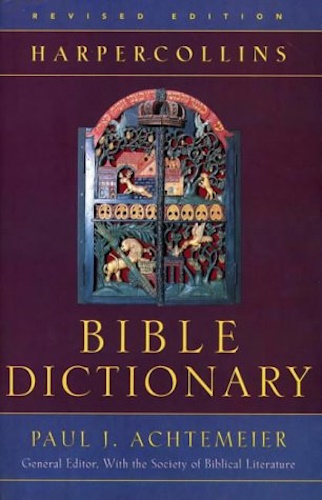



-
Urantia Book, 44:0.11 - The Celestial Artisans
Never in your long ascendancy will you lose the power to recognize your associates of former existences. Always, as you ascend inward in the scale of life, will you retain the ability to recognize and fraternize with the fellow beings of your previous and lower levels of experience. Each new translation or resurrection will add one more group of spirit beings to your vision range without in the least depriving you of the ability to recognize your friends and fellows of former estates.
-
Princess Bride 1987 Wallace Shawn (Vizzini) and Mandy Patinkin (Inigo Montoya)
Vizzini: HE DIDN'T FALL? INCONCEIVABLE.
Inigo Montoya: You keep using that word. I do not think it means what you think it means. -
Urantia Book, 117:4.14 - The Finite God
And here is mystery: The more closely man approaches God through love, the greater the reality -- actuality -- of that man. The more man withdraws from God, the more nearly he approaches nonreality -- cessation of existence. When man consecrates his will to the doing of the Father's will, when man gives God all that he has, then does God make that man more than he is.
-
Urantia Book, 167:7.4 - The Talk About Angels
"And do you not remember that I said to you once before that, if you had your spiritual eyes anointed, you would then see the heavens opened and behold the angels of God ascending and descending? It is by the ministry of the angels that one world may be kept in touch with other worlds, for have I not repeatedly told you that I have other sheep not of this fold?"
-
Urantia Book, Foreword - 0:12.12 - The Trinities
But we know that there dwells within the human mind a fragment of God, and that there sojourns with the human soul the Spirit of Truth; and we further know that these spirit forces conspire to enable material man to grasp the reality of spiritual values and to comprehend the philosophy of universe meanings. But even more certainly we know that these spirits of the Divine Presence are able to assist man in the spiritual appropriation of all truth contributory to the enhancement of the ever-progressing reality of personal religious experience—God-consciousness.
-
Urantia Book, 1:4.3 - The Mystery Of God
When you are through down here, when your course has been run in temporary form on earth, when your trial trip in the flesh is finished, when the dust that composes the mortal tabernacle "returns to the earth whence it came"; then, it is revealed, the indwelling "Spirit shall return to God who gave it." There sojourns within each moral being of this planet a fragment of God, a part and parcel of divinity. It is not yet yours by right of possession, but it is designedly intended to be one with you if you survive the mortal existence.
-
Urantia Book, 1:4.1 - The Mystery Of God
And the greatest of all the unfathomable mysteries of God is the phenomenon of the divine indwelling of mortal minds. The manner in which the Universal Father sojourns with the creatures of time is the most profound of all universe mysteries; the divine presence in the mind of man is the mystery of mysteries.
-
Urantia Book, 1:4.6 - The Mystery Of God
To every spirit being and to every mortal creature in every sphere and on every world of the universe of universes, the Universal Father reveals all of his gracious and divine self that can be discerned or comprehended by such spirit beings and by such mortal creatures. God is no respecter of persons, either spiritual or material. The divine presence which any child of the universe enjoys at any given moment is limited only by the capacity of such a creature to receive and to discern the spirit actualities of the supermaterial world.
-
Urantia Book, 11:0.1 - The Eternal Isle Of Paradise
Paradise is the eternal center of the universe of universes and the abiding place of the Universal Father, the Eternal Son, the Infinite Spirit, and their divine co-ordinates and associates. This central Isle is the most gigantic organized body of cosmic reality in all the master universe. Paradise is a material sphere as well as a spiritual abode. All of the intelligent creation of the Universal Father is domiciled on material abodes; hence must the absolute controlling center also be material, literal. And again it should be reiterated that spirit things and spiritual beings are real.
-
Urantia Book, 50:6.4 - Planetary Culture
Culture presupposes quality of mind; culture cannot be enhanced unless mind is elevated. Superior intellect will seek a noble culture and find some way to attain such a goal. Inferior minds will spurn the highest culture even when presented to them ready-made.
-
Urantia Book, 54:1.6 - True And False Liberty
True liberty is the associate of genuine self-respect; false liberty is the consort of self-admiration. True liberty is the fruit of self-control; false liberty, the assumption of self-assertion. Self-control leads to altruistic service; self-admiration tends towards the exploitation of others for the selfish aggrandizement of such a mistaken individual as is willing to sacrifice righteous attainment for the sake of possessing unjust power over his fellow beings.
-
Urantia Book, 54:1.9 - True And False Liberty
How dare the self-willed creature encroach upon the rights of his fellows in the name of personal liberty when the Supreme Rulers of the universe stand back in merciful respect for these prerogatives of will and potentials of personality! No being, in the exercise of his supposed personal liberty, has a right to deprive any other being of those privileges of existence conferred by the Creators and duly respected by all their loyal associates, subordinates, and subjects.
-
Urantia Book, 54:1.8 - True And False Liberty
There is no error greater than that species of self-deception which leads intelligent beings to crave the exercise of power over other beings for the purpose of depriving these persons of their natural liberties. The golden rule of human fairness cries out against all such fraud, unfairness, selfishness, and unrighteousness.


